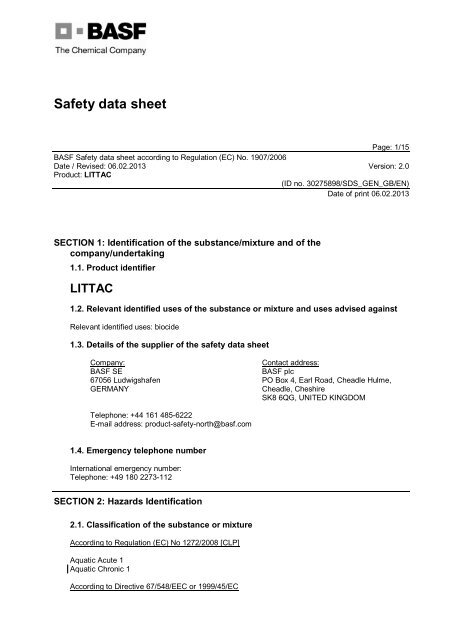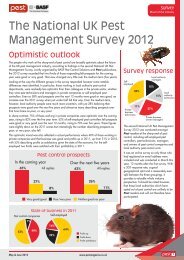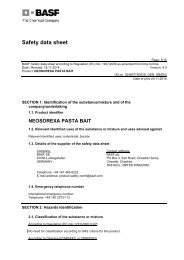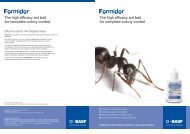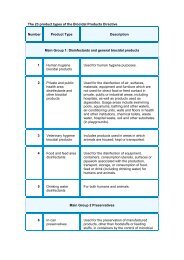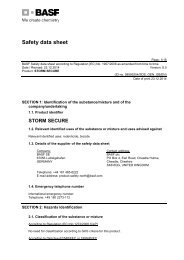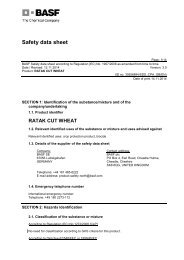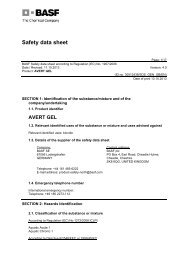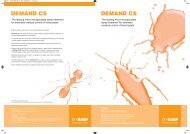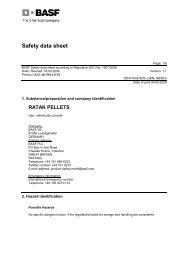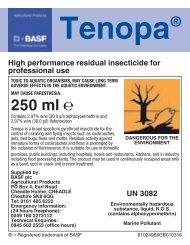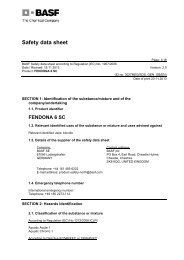Littac MSDS - Pest Control Management - BASF
Littac MSDS - Pest Control Management - BASF
Littac MSDS - Pest Control Management - BASF
Create successful ePaper yourself
Turn your PDF publications into a flip-book with our unique Google optimized e-Paper software.
Safety data sheetPage: 1/15<strong>BASF</strong> Safety data sheet according to Regulation (EC) No. 1907/2006Date / Revised: 06.02.2013 Version: 2.0Product: LITTAC(ID no. 30275898/SDS_GEN_GB/EN)Date of print 06.02.2013SECTION 1: Identification of the substance/mixture and of thecompany/undertaking1.1. Product identifierLITTAC1.2. Relevant identified uses of the substance or mixture and uses advised againstRelevant identified uses: biocide1.3. Details of the supplier of the safety data sheetCompany:<strong>BASF</strong> SE67056 LudwigshafenGERMANYContact address:<strong>BASF</strong> plcPO Box 4, Earl Road, Cheadle Hulme,Cheadle, CheshireSK8 6QG, UNITED KINGDOMTelephone: +44 161 485-6222E-mail address: product-safety-north@basf.com1.4. Emergency telephone numberInternational emergency number:Telephone: +49 180 2273-112SECTION 2: Hazards Identification2.1. Classification of the substance or mixtureAccording to Regulation (EC) No 1272/2008 [CLP]Aquatic Acute 1Aquatic Chronic 1According to Directive 67/548/EEC or 1999/45/EC
Page: 2/15<strong>BASF</strong> Safety data sheet according to Regulation (EC) No. 1907/2006Date / Revised: 06.02.2013 Version: 2.0Product: LITTAC(ID no. 30275898/SDS_GEN_GB/EN)Date of print 06.02.2013Possible Hazards:Very toxic to aquatic organisms, may cause long-term adverse effects in the aquatic environment.For the classifications not written out in full in this section the full text can be found in section 16.2.2. Label elementsGlobally Harmonized System, EU (GHS)Pictogram:Signal Word:WarningHazard Statement:H400H410Very toxic to aquatic life.Very toxic to aquatic life with long lasting effects.Precautionary Statements (Response):P391Collect spillage.Labeling of special preparations (GHS):May cause paraesthesia. alpha-CypermethrinAccording to Directive 67/548/EEC or 1999/45/ECClassification/labelling in accordance with UK regulations.Hazard symbol(s)NDangerous for the environment.R-phrase(s)R50/53 Very toxic to aquatic organisms, may cause long-term adverse effectsin the aquatic environment.S-phrase(s)
Page: 3/15<strong>BASF</strong> Safety data sheet according to Regulation (EC) No. 1907/2006Date / Revised: 06.02.2013 Version: 2.0Product: LITTAC(ID no. 30275898/SDS_GEN_GB/EN)Date of print 06.02.2013S2Keep out of the reach of children.S7Keep container tightly closed.S13Keep away from food, drink and animal feeding stuffs.S20/21 When using do not eat, drink or smoke.S23Do not breathe gas/fumes/vapour/spray (appropriate wording to bespecified by the manufacturer).S24Avoid contact with skin.S29Do not empty into drains.S35This material and its container must be disposed of in a safe way.S36/37 Wear suitable protective clothing and gloves.S57Use appropriate container to avoid environmental contamination.S61Avoid release to the environment. Refer to special instructions/safetydata sheets.The product contains: alpha-CypermethrinMay cause paraesthesia.2.3. Other hazardsAccording to Regulation (EC) No 1272/2008 [CLP]See section 12 - Results of PBT and vPvB assessment.If applicable information is provided in this section on other hazards which do not result inclassification but which may contribute to the overall hazards of the substance or mixture.SECTION 3: Composition/Information on Ingredients3.1. SubstancesNot applicable3.2. MixturesChemical naturebiocide, insecticide, suspension concentrate (SC)Hazardous ingredients (GHS)according to Regulation (EC) No. 1272/2008
Page: 4/15<strong>BASF</strong> Safety data sheet according to Regulation (EC) No. 1907/2006Date / Revised: 06.02.2013 Version: 2.0Product: LITTAC(ID no. 30275898/SDS_GEN_GB/EN)Date of print 06.02.2013.alpha.-cypermethrin (ISO); racemate comprising (R)-.alpha.-cyano-3-phenoxybenzyl (1S,3S)-3-(2,2-dichlorovinyl)-2,2-dimethylcyclopropanecarboxylate; (S)-.alpha.-cyano-3-phenoxybenzyl (1R,3R)-3-(2,2-dichlorovinyl)-2,2-dimethylcyclopropanecarboxylateContent (W/W): 1.5 %CAS Number: 67375-30-8INDEX-Number: 607-422-00-XAcute Tox. 4 (Inhalation - dust)Acute Tox. 3 (oral)STOT SE 3 (irr. to respiratory syst.)STOT RE 2Aquatic Acute 1Aquatic Chronic 1M-factor acute: 10000M-factor chronic: 1000H301, H332, H335, H373, H400, H410Propane-1,2-diolContent (W/W): < 15 %CAS Number: 57-55-6EC-Number: 200-338-0REACH registration number: 01-2119456809-23Hazardous ingredientsaccording to Directive 1999/45/EC.alpha.-cypermethrin (ISO); racemate comprising (R)-.alpha.-cyano-3-phenoxybenzyl (1S,3S)-3-(2,2-dichlorovinyl)-2,2-dimethylcyclopropanecarboxylate; (S)-.alpha.-cyano-3-phenoxybenzyl (1R,3R)-3-(2,2-dichlorovinyl)-2,2-dimethylcyclopropanecarboxylateContent (W/W): 1.5 %CAS Number: 67375-30-8INDEX-Number: 607-422-00-XPropane-1,2-diolContent (W/W): < 15 %CAS Number: 57-55-6EC-Number: 200-338-0REACH registration number: 01-2119456809-23For the classifications not written out in full in this section, including the indication of danger, thehazard symbols, the R phrases, and the hazard statements, the full text is listed in section 16.SECTION 4: First-Aid Measures4.1. Description of first aid measuresRemove contaminated clothing.Show container, label and/or safety data sheet to physician.If inhaled:
Page: 5/15<strong>BASF</strong> Safety data sheet according to Regulation (EC) No. 1907/2006Date / Revised: 06.02.2013 Version: 2.0Product: LITTAC(ID no. 30275898/SDS_GEN_GB/EN)Date of print 06.02.2013Keep patient calm, remove to fresh air.On skin contact:Wash thoroughly with soap and water.On contact with eyes:Wash affected eyes for at least 15 minutes under running water with eyelids held open.On ingestion:Rinse mouth and then drink plenty of water.4.2. Most important symptoms and effects, both acute and delayedSymptoms: numbness and tingling of hands and feet, convulsions4.3. Indication of any immediate medical attention and special treatment neededTreatment: Symptomatic treatment (decontamination, vital functions).SECTION 5: Fire-Fighting Measures5.1. Extinguishing mediaSuitable extinguishing media:water spray, foam, dry powder, carbon dioxide5.2. Special hazards arising from the substance or mixturecarbon monoxide, hydrogen chloride, hydrogen cyanide; hydrocyanic acid, Carbon dioxide, nitrogenoxides, organochloric compoundsThe substances/groups of substances mentioned can be released in case of fire.5.3. Advice for fire-fightersSpecial protective equipment:Wear self-contained breathing apparatus and chemical-protective clothing.Further information:In case of fire and/or explosion do not breathe fumes. Keep containers cool by spraying with water ifexposed to fire. Collect contaminated extinguishing water separately, do not allow to reach sewageor effluent systems. Dispose of fire debris and contaminated extinguishing water in accordance withofficial regulations.SECTION 6: Accidental Release Measures6.1. Personal precautions, protective equipment and emergency proceduresUse personal protective clothing. Avoid contact with the skin, eyes and clothing. Do not breathevapour/spray.6.2. Environmental precautionsDo not allow contamination of public drains or surface or ground waters. Inform local water plc ifspillage enters drains and the Environment Agency (England & Wales), the Scottish Environmental
Page: 6/15<strong>BASF</strong> Safety data sheet according to Regulation (EC) No. 1907/2006Date / Revised: 06.02.2013 Version: 2.0Product: LITTAC(ID no. 30275898/SDS_GEN_GB/EN)Date of print 06.02.2013Protection Agency (Scotland), or the Environment and Heritage Service (Northern Ireland) if it enterssurface or ground waters. Keep people and animals away.6.3. Methods and material for containment and cleaning upFor small amounts: Pick up with suitable absorbent material (e.g. sand, sawdust, general-purposebinder, kieselguhr).For large amounts: Dike spillage. Pump off product.Dispose of absorbed material in accordance with regulations. Collect waste in suitable containers,which can be labeled and sealed. Clean contaminated floors and objects thoroughly with water anddetergents, observing environmental regulations. Incinerate or take to a special waste disposal sitein accordance with local authority regulations.6.4. Reference to other sectionsInformation regarding exposure controls/personal protection and disposal considerations can befound in section 8 and 13.SECTION 7: Handling and Storage7.1. Precautions for safe handlingNo special measures necessary if stored and handled correctly. Ensure thorough ventilation ofstores and work areas. When using do not eat, drink or smoke. Hands and/or face should be washedbefore breaks and at the end of the shift.Protection against fire and explosion:No special precautions necessary. The substance/product is non-combustible. Product is notexplosive.7.2. Conditions for safe storage, including any incompatibilitiesSegregate from foods and animal feeds.Further information on storage conditions: Keep away from heat. Protect from direct sunlight. Protectagainst moisture.Protect from temperatures below: 0 °CThe product can crystallize below the limit temperature.Protect from temperatures above: 40 °CChanges in the properties of the product may occur if substance/product is stored above indicatedtemperature for extended periods of time.7.3. Specific end use(s)For the relevant identified use(s) listed in Section 1 the advice mentioned in this section 7 is to beobserved.SECTION 8: Exposure <strong>Control</strong>s/Personal Protection8.1. <strong>Control</strong> parametersComponents with occupational exposure limits
Page: 7/15<strong>BASF</strong> Safety data sheet according to Regulation (EC) No. 1907/2006Date / Revised: 06.02.2013 Version: 2.0Product: LITTAC(ID no. 30275898/SDS_GEN_GB/EN)Date of print 06.02.201357-55-6: Propane-1,2-diolTWA value 10 mg/m3 (WEL/EH 40 (UK)), ParticulateTWA value 474 mg/m3 ; 150 ppm (WEL/EH 40 (UK)), Total vapour andparticulatesRefer to the current edition of HSE Guidance Note EH40 Occupational Exposure Limits (UnitedKingdom). For normal use and handling refer to the product label/leaflet. In all other cases thefollowing apply.8.2. Exposure controlsPersonal protective equipmentRespiratory protection:Respiratory protection not required.Hand protection:Suitable chemical resistant safety gloves (EN 374) also with prolonged, direct contact(Recommended: Protective index 6, corresponding > 480 minutes of permeation time according toEN 374): E.g. nitrile rubber (0.4 mm), chloroprene rubber (0.5 mm), butyl rubber (0.7 mm) and otherEye protection:Safety glasses with side-shields (frame goggles) (e.g. EN 166)Body protection:Body protection must be chosen depending on activity and possible exposure, e.g. apron, protectingboots, chemical-protection suit (according to EN 14605 in case of splashes or EN ISO 13982 in caseof dust).General safety and hygiene measuresHandle in accordance with good industrial hygiene and safety practice. Wearing of closed workclothing is recommended. Avoid contact with the skin, eyes and clothing. Store work clothingseparately. Keep away from food, drink and animal feeding stuffs.SECTION 9: Physical and Chemical Properties9.1. Information on basic physical and chemical propertiesForm:suspensionColour:whiteOdour:odourlessOdour threshold:not applicable, odour not perceivablepH value: approx. 6 - 8(10 g/l, 20 °C)Freezing point: -5.9 °Conset of boiling: approx. 100 °C(1,013 hPa)
Page: 8/15<strong>BASF</strong> Safety data sheet according to Regulation (EC) No. 1907/2006Date / Revised: 06.02.2013 Version: 2.0Product: LITTAC(ID no. 30275898/SDS_GEN_GB/EN)Date of print 06.02.2013Flash point:(DIN EN 22719; ISO 2719)No flash point - Measurement madeup to the boiling point.Evaporation rate:not applicableFlammability:not flammableLower explosion limit:not determinedUpper explosion limit:not determinedIgnition temperature: 425 °CThe product has not been tested.The statement has been derived fromsubstances/products of a similarstructure or composition.Vapour pressure: approx. 23.4 hPa(20 °C)Information applies to the solvent.Density:approx. 1.00 - 1.05 g/cm3(OECD Guideline 109)(20 °C)Relative vapour density (air):not determinedSolubility in water: dispersiblePartitioning coefficient n-octanol/water (log Kow):not applicableThermal decomposition: not determinedViscosity, dynamic: 21 mPa.s(OECD 114)(40 °C, 100 1/s)Viscosity, kinematic: 20.6 mm2/s(40 °C)Explosion hazard: not explosiveFire promoting properties: not fire-propagating9.2. Other informationOther Information:If necessary, information on other physical and chemical parameters is indicated in this section.SECTION 10: Stability and Reactivity10.1. ReactivityNo hazardous reactions if stored and handled as prescribed/indicated.Corrosion to metals:mild steel tin10.2. Chemical stabilityThe product is stable if stored and handled as prescribed/indicated.10.3. Possibility of hazardous reactionsNo hazardous reactions if stored and handled as prescribed/indicated.
Page: 9/15<strong>BASF</strong> Safety data sheet according to Regulation (EC) No. 1907/2006Date / Revised: 06.02.2013 Version: 2.0Product: LITTAC(ID no. 30275898/SDS_GEN_GB/EN)Date of print 06.02.201310.4. Conditions to avoidSee <strong>MSDS</strong> section 7 - Handling and storage.10.5. Incompatible materialsSubstances to avoid:strong bases, strong acids, strong oxidizing agents10.6. Hazardous decomposition productsHazardous decomposition products:No hazardous decomposition products if stored and handled as prescribed/indicated.SECTION 11: Toxicological Information11.1. Information on toxicological effectsAcute toxicityAssessment of acute toxicity:The product has not been tested. The statement has been derived from substances/products of asimilar structure or composition. Of low toxicity after single ingestion. Virtually nontoxic after a singleskin contact. Virtually nontoxic by inhalation.Experimental/calculated data:LD50 rat (oral): > 2,000 mg/kgLC50 rat (by inhalation): > 2.06 mg/l 4 hNo mortality was observed.LD50 rat (dermal): > 2,000 mg/kgIrritationAssessment of irritating effects:The product has not been tested. The statement has been derived from substances/products of asimilar structure or composition. Not irritating to the eyes. Not irritating to the skin.Experimental/calculated data:Serious eye damage/irritation rabbit: non-irritantRespiratory/Skin sensitizationAssessment of sensitization:The product has not been tested. The statement has been derived from substances/products of asimilar structure or composition. There is no evidence of a skin-sensitizing potential.Experimental/calculated data:
Page: 10/15<strong>BASF</strong> Safety data sheet according to Regulation (EC) No. 1907/2006Date / Revised: 06.02.2013 Version: 2.0Product: LITTAC(ID no. 30275898/SDS_GEN_GB/EN)Date of print 06.02.2013modified Buehler test guinea pig: Skin sensitizing effects were not observed in animal studies.Germ cell mutagenicityAssessment of mutagenicity:The product has not been tested. The statement has been derived from the properties of theindividual components. Mutagenicity tests revealed no genotoxic potential.CarcinogenicityAssessment of carcinogenicity:The product has not been tested. The statement has been derived from the properties of theindividual components. The results of various animal studies gave no indication of a carcinogeniceffect.Reproductive toxicityAssessment of reproduction toxicity:The product has not been tested. The statement has been derived from the properties of theindividual components. The results of animal studies gave no indication of a fertility impairing effect.Developmental toxicityAssessment of teratogenicity:The product has not been tested. The statement has been derived from the properties of theindividual components. Animal studies gave no indication of a developmental toxic effect at dosesthat were not toxic to the parental animals.Repeated dose toxicity and Specific target organ toxicity (repeated exposure)Assessment of repeated dose toxicity:The product has not been tested. The statement has been derived from the properties of theindividual components.Information on: .alpha.-cypermethrin (ISO); racemate comprising (R)-.alpha.-cyano-3-phenoxybenzyl(1S,3S)-3-(2,2-dichlorovinyl)-2,2-dimethylcyclopropanecarboxylate; (S)-.alpha.-cyano-3-phenoxybenzyl (1R,3R)-3-(2,2-dichlorovinyl)-2,2-dimethylcyclopropanecarboxylateAssessment of repeated dose toxicity:Repeated oral exposure may affect certain organs. Damages the peripheral nerve system.----------------------------------Other relevant toxicity informationMisuse can be harmful to health. May cause paraesthesia.SECTION 12: Ecological Information12.1. ToxicityAssessment of aquatic toxicity:Very toxic to aquatic organisms.
Page: 11/15<strong>BASF</strong> Safety data sheet according to Regulation (EC) No. 1907/2006Date / Revised: 06.02.2013 Version: 2.0Product: LITTAC(ID no. 30275898/SDS_GEN_GB/EN)Date of print 06.02.2013Information on: .alpha.-cypermethrin (ISO); racemate comprising (R)-.alpha.-cyano-3-phenoxybenzyl(1S,3S)-3-(2,2-dichlorovinyl)-2,2-dimethylcyclopropanecarboxylate; (S)-.alpha.-cyano-3-phenoxybenzyl (1R,3R)-3-(2,2-dichlorovinyl)-2,2-dimethylcyclopropanecarboxylateToxicity to fish:LC50 (96 h) 0.00093 mg/l, Pimephales promelas (OPP 72-1 (EPA-Guideline), Flow through.)----------------------------------Information on: .alpha.-cypermethrin (ISO); racemate comprising (R)-.alpha.-cyano-3-phenoxybenzyl(1S,3S)-3-(2,2-dichlorovinyl)-2,2-dimethylcyclopropanecarboxylate; (S)-.alpha.-cyano-3-phenoxybenzyl (1R,3R)-3-(2,2-dichlorovinyl)-2,2-dimethylcyclopropanecarboxylateAquatic invertebrates:EC50 (48 h) 12,6 ng/L, Chironomus riparius (OECD Guideline 202, part 1, static)----------------------------------Information on: .alpha.-cypermethrin (ISO); racemate comprising (R)-.alpha.-cyano-3-phenoxybenzyl(1S,3S)-3-(2,2-dichlorovinyl)-2,2-dimethylcyclopropanecarboxylate; (S)-.alpha.-cyano-3-phenoxybenzyl (1R,3R)-3-(2,2-dichlorovinyl)-2,2-dimethylcyclopropanecarboxylateAquatic plants:EC50 (72 h) > 1 mg/l (growth rate), Scenedesmus subspicatus (OECD Guideline 201, static)No observed effect concentration (7 d) >= 1,39 µg/L (growth rate), Lemna gibba (OECD guideline221, static)----------------------------------Information on: .alpha.-cypermethrin (ISO); racemate comprising (R)-.alpha.-cyano-3-phenoxybenzyl(1S,3S)-3-(2,2-dichlorovinyl)-2,2-dimethylcyclopropanecarboxylate; (S)-.alpha.-cyano-3-phenoxybenzyl (1R,3R)-3-(2,2-dichlorovinyl)-2,2-dimethylcyclopropanecarboxylateChronic toxicity to fish:No observed effect concentration (34 d) 0,03 µg/L, Pimephales promelas (OPP 72-4 (EPA-Guideline), Flow through.)----------------------------------Information on: .alpha.-cypermethrin (ISO); racemate comprising (R)-.alpha.-cyano-3-phenoxybenzyl(1S,3S)-3-(2,2-dichlorovinyl)-2,2-dimethylcyclopropanecarboxylate; (S)-.alpha.-cyano-3-phenoxybenzyl (1R,3R)-3-(2,2-dichlorovinyl)-2,2-dimethylcyclopropanecarboxylateChronic toxicity to aquatic invertebrates:No observed effect concentration (28 d) 0,024 µg/L, Chironomus riparius (OECD 219, static)No observed effect concentration (21 d) 0,03 µg/L, Daphnia magna (OPP 72-4 (EPA-Guideline),semistatic)----------------------------------12.2. Persistence and degradabilityAssessment biodegradation and elimination (H2O):The product has not been tested. The statement has been derived from the properties of theindividual components.Information on: .alpha.-cypermethrin (ISO); racemate comprising (R)-.alpha.-cyano-3-phenoxybenzyl(1S,3S)-3-(2,2-dichlorovinyl)-2,2-dimethylcyclopropanecarboxylate; (S)-.alpha.-cyano-3-phenoxybenzyl (1R,3R)-3-(2,2-dichlorovinyl)-2,2-dimethylcyclopropanecarboxylate
Page: 12/15<strong>BASF</strong> Safety data sheet according to Regulation (EC) No. 1907/2006Date / Revised: 06.02.2013 Version: 2.0Product: LITTAC(ID no. 30275898/SDS_GEN_GB/EN)Date of print 06.02.2013Assessment biodegradation and elimination (H2O):Not readily biodegradable (by OECD criteria). Poorly biodegradable.----------------------------------12.3. Bioaccumulative potentialAssessment bioaccumulation potential:The product has not been tested. The statement has been derived from the properties of theindividual components.Information on: .alpha.-cypermethrin (ISO); racemate comprising (R)-.alpha.-cyano-3-phenoxybenzyl(1S,3S)-3-(2,2-dichlorovinyl)-2,2-dimethylcyclopropanecarboxylate; (S)-.alpha.-cyano-3-phenoxybenzyl (1R,3R)-3-(2,2-dichlorovinyl)-2,2-dimethylcyclopropanecarboxylateBioaccumulation potential:Bioconcentration factor: 155 - 910 (73 d), Cyprinus carpio (OECD Guideline 305 C)Accumulation in organisms is not to be expected.----------------------------------12.4. Mobility in soil (and other compartments if available)Assessment transport between environmental compartments:The product has not been tested. The statement has been derived from the properties of theindividual components.Information on: .alpha.-cypermethrin (ISO); racemate comprising (R)-.alpha.-cyano-3-phenoxybenzyl(1S,3S)-3-(2,2-dichlorovinyl)-2,2-dimethylcyclopropanecarboxylate; (S)-.alpha.-cyano-3-phenoxybenzyl (1R,3R)-3-(2,2-dichlorovinyl)-2,2-dimethylcyclopropanecarboxylateAssessment transport between environmental compartments:Following exposure to soil, adsorption to solid soil particles is probable, therefore contamination ofgroundwater is not expected.----------------------------------12.5. Results of PBT and vPvB assessmentThe product does not contain a substance fullfilling the PBT (persistent/bioaccumulative/toxic)criteria or the vPvB (very persistent/very bioaccumulative) criteria.12.6. Other adverse effectsThe product does not contain substances that are listed in Annex I of Regulation (EC) 2037/2000 onsubstances that deplete the ozone layer.12.7. Additional informationOther ecotoxicological advice:Do not discharge product into the environment without control.SECTION 13: Disposal Considerations13.1. Waste treatment methods
Page: 13/15<strong>BASF</strong> Safety data sheet according to Regulation (EC) No. 1907/2006Date / Revised: 06.02.2013 Version: 2.0Product: LITTAC(ID no. 30275898/SDS_GEN_GB/EN)Date of print 06.02.2013Must be disposed of or incinerated in accordance with local regulations.The UK Environmental Protection (Duty of Care) Regulations (EP) and amendments should be noted(United Kingdom).This product and any uncleaned containers must be disposed of as hazardous waste in accordancewith the 2005 Hazardous Waste Regulations and amendments (United Kingdom)Contaminated packaging:Contaminated packaging should be emptied as far as possible and disposed of in the same manneras the substance/product.SECTION 14: Transport InformationLand transportADRUN numberUN3082UN proper shipping name: ENVIRONMENTALLY HAZARDOUS SUBSTANCE, LIQUID,N.O.S. (contains ALPHA-CYPERMETHRIN)Transport hazard class(es): 9, EHSMPacking group:IIIEnvironmental hazards: yesSpecial precautions for Tunnel code: Euser:RIDUN numberUN3082UN proper shipping name: ENVIRONMENTALLY HAZARDOUS SUBSTANCE, LIQUID,N.O.S. (contains ALPHA-CYPERMETHRIN)Transport hazard class(es): 9, EHSMPacking group:IIIEnvironmental hazards: yesSpecial precautions for None knownuser:Inland waterway transportADNUN numberUN3082UN proper shipping name: ENVIRONMENTALLY HAZARDOUS SUBSTANCE, LIQUID,N.O.S. (contains ALPHA-CYPERMETHRIN)Transport hazard class(es): 9, EHSMPacking group:IIIEnvironmental hazards: yesSpecial precautions for None knownuser:
Page: 14/15<strong>BASF</strong> Safety data sheet according to Regulation (EC) No. 1907/2006Date / Revised: 06.02.2013 Version: 2.0Product: LITTAC(ID no. 30275898/SDS_GEN_GB/EN)Date of print 06.02.2013Transport in inland Not evaluatedwaterway vessel:Sea transportIMDGUN number: UN 3082UN proper shipping name: ENVIRONMENTALLY HAZARDOUS SUBSTANCE, LIQUID,N.O.S. (contains ALPHA-CYPERMETHRIN)Transport hazard class(es): 9, EHSMPacking group:IIIEnvironmental hazards: yesMarine pollutant: YESSpecial precautions for None knownuser:Air transportIATA/ICAOUN number: UN 3082UN proper shipping name: ENVIRONMENTALLY HAZARDOUS SUBSTANCE, LIQUID,N.O.S. (contains ALPHA-CYPERMETHRIN)Transport hazard class(es): 9, EHSMPacking group:IIIEnvironmental hazards: yesSpecial precautions for None knownuser:Transport in bulk according to Annex II of MARPOL73/78 and the IBC CodeRegulation:Not evaluatedShipment approved: Not evaluatedPollution name:Not evaluatedPollution category: Not evaluatedShip Type:Not evaluatedFurther informationThis product is subject to the most recent edition of "The Carriage of Dangerous Goods and Use ofTransportable Pressure Equipment Regulations" and their amendments (United Kingdom).SECTION 15: Regulatory Information15.1. Safety, health and environmental regulations/legislation specific for thesubstance or mixture
Page: 15/15<strong>BASF</strong> Safety data sheet according to Regulation (EC) No. 1907/2006Date / Revised: 06.02.2013 Version: 2.0Product: LITTAC(ID no. 30275898/SDS_GEN_GB/EN)Date of print 06.02.2013If other regulatory information applies that is not already provided elsewhere in this safety datasheet, then it is described in this subsection.To avoid risks to man and the environment, comply with the instructions for use.The data should be considered when making any assessment under the <strong>Control</strong> of SubstancesHazardous to Health Regulations (COSHH), and related guidance, for example, 'COSHH Essentials'(United Kingdom).This product is classified under the Chemicals (Hazard Information and Packaging) Regulations,(CHIP) (United Kingdom).This product may be subject to the <strong>Control</strong> of Major Accident Hazards Regulations (COMAH), andamendments if specific threshold tonnages are exceeded (United Kingdom).15.2. Chemical Safety AssessmentA chemical safety assessment acc. to art. 14 of Regulation (EC) No 1907/2006 is not required,because art. 15 of the same regulation applies.SECTION 16: Other InformationFor proper and safe use of this product, please refer to the approval conditions laid down on theproduct label.Full text of the classifications, including the indication of danger, the hazard symbols, the R phrases,and the hazard statements, if mentioned in section 2 or 3:Aquatic AcuteHazardous to the aquatic environment - acuteAquatic Chronic Hazardous to the aquatic environment - chronicAcute Tox.Acute toxicitySTOT SESpecific target organ toxicity — single exposureSTOT RESpecific target organ toxicity — repeated exposureH301Toxic if swallowed.H332Harmful if inhaled.H335May cause respiratory irritation.H373May cause damage to organs through prolonged or repeated exposure.H400Very toxic to aquatic life.H410Very toxic to aquatic life with long lasting effects.If you have any queries relating to this <strong>MSDS</strong>, it's contents or any other product safety related questions,please write to the following e-mail address: product-safety-north@basf.comThe data contained in this safety data sheet are based on our current knowledge and experience anddescribe the product only with regard to safety requirements. The data do not describe the product'sproperties (product specification). Neither should any agreed property nor the suitability of the product forany specific purpose be deduced from the data contained in the safety data sheet. It is the responsibilityof the recipient of the product to ensure any proprietary rights and existing laws and legislation areobserved.Vertical lines in the left hand margin indicate an amendment from the previous version.


